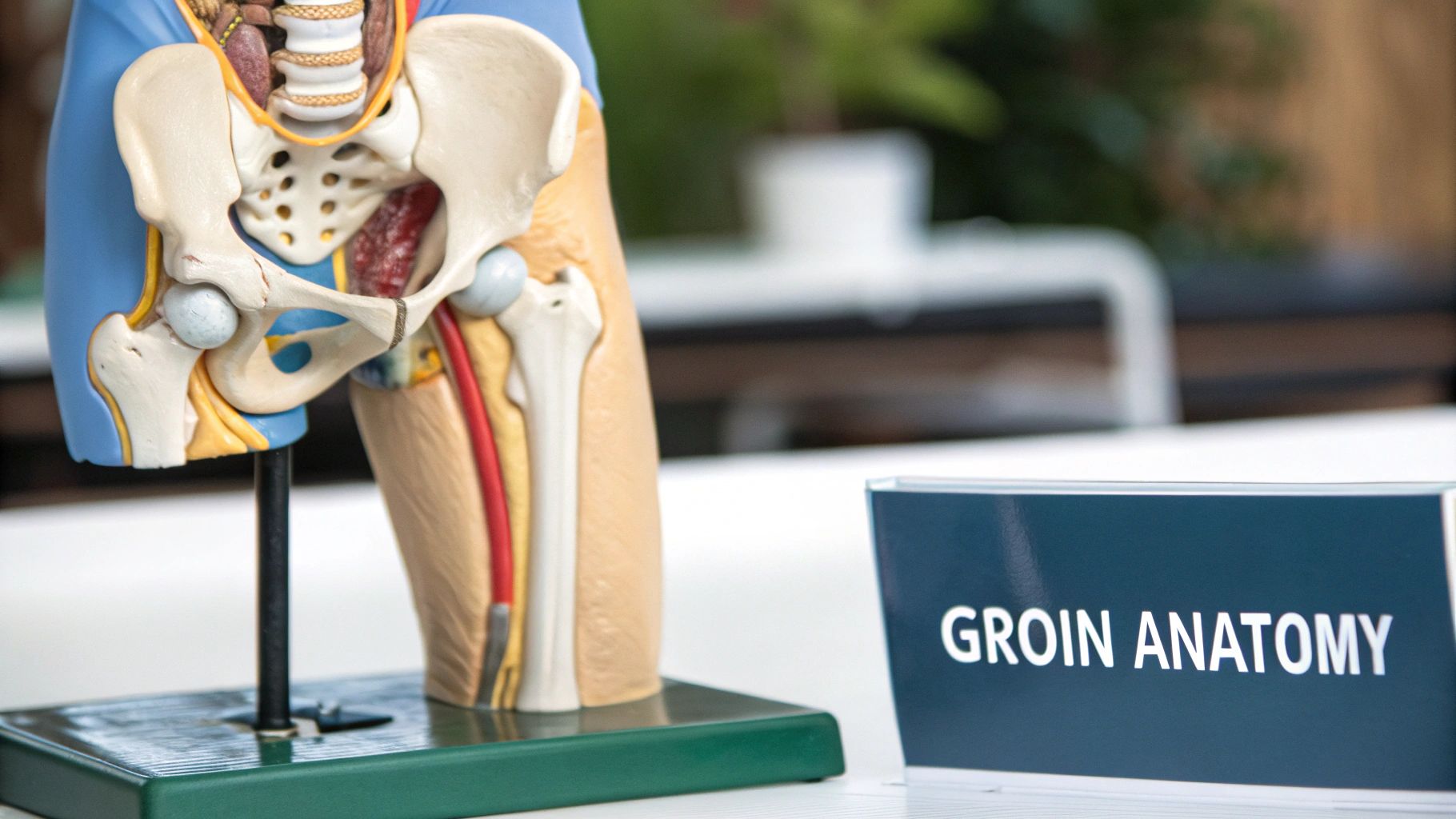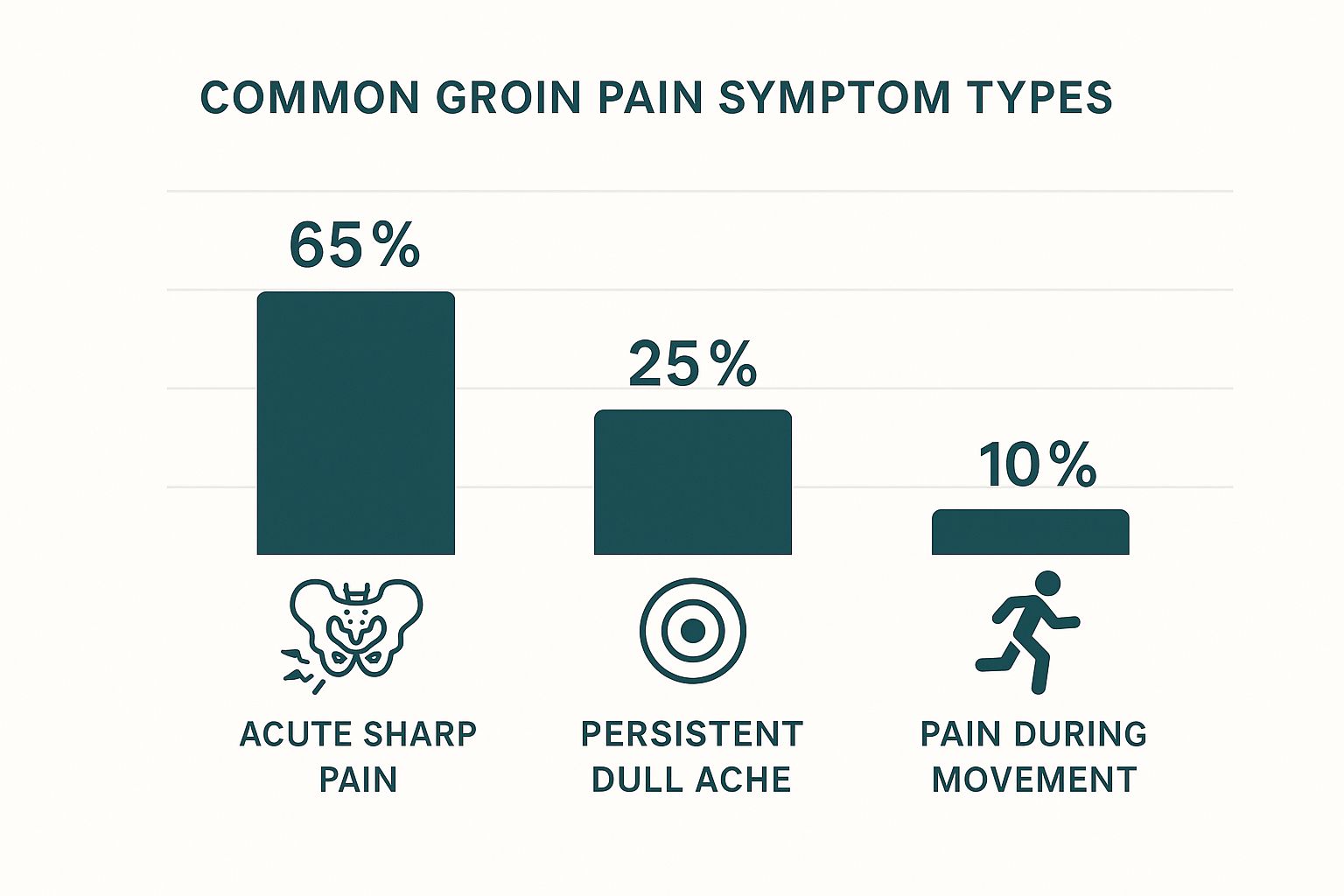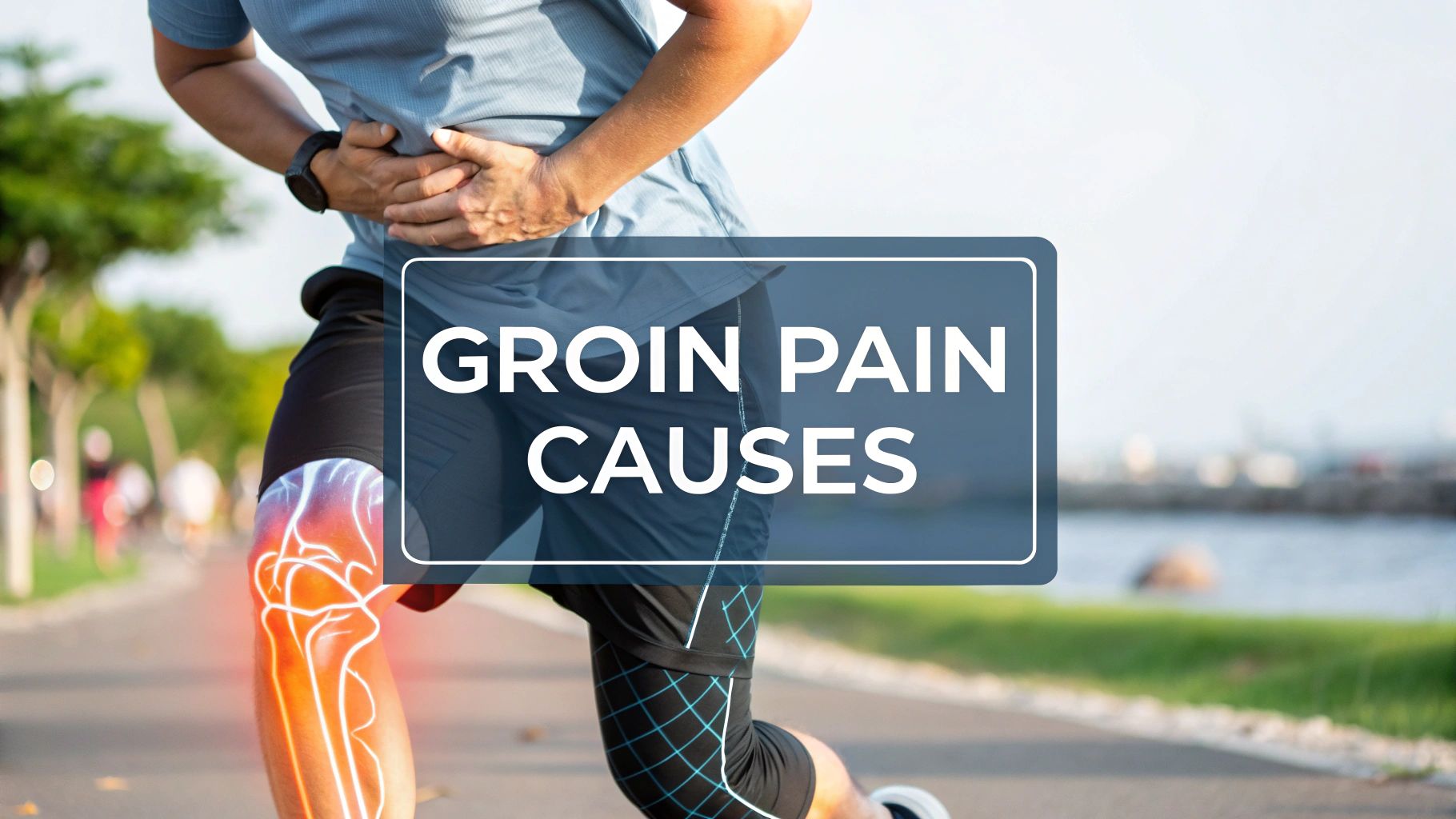.webp)
If you’re grappling with groin pain, the first thing to realise is that the pain itself isn’t the problem—it's a signal. While it’s often down to a straightforward muscle strain, that discomfort can also point to a hernia, a hip joint issue, or even a problem that’s being referred from another part of your body. Getting to the root of it is the first real step toward relief.

Think of your groin as a busy anatomical crossroads. It's the junction where your upper thigh meets your lower abdomen, home to a complex network of muscles, ligaments, nerves, and blood vessels. When everything is working in harmony, this junction gives us a fantastic range of motion. But if any single part gets injured or irritated, it can trigger anything from a dull ache to a sharp, debilitating pain.
That feeling of pain is just your body's alarm system, telling you that something needs attention. Given how much is going on in this one area, the list of potential culprits for groin pain is surprisingly long. It's not just about pulled muscles from sport; the discomfort can come from several different body systems entirely.
To make sense of it all, it helps to group the potential causes. The pain you're feeling could be related to:
This huge range of possibilities is exactly why self-diagnosing can be so tricky. A dull ache after a workout might just be a simple strain, but pain that’s persistent or severe could be flagging up something more serious.
To help you get a clearer picture, here’s a quick summary of where the pain might be coming from.
This table is just a starting point, but it shows how different issues can present themselves.
Pain is an incredibly common experience in the UK. A major systematic review found that 43% of adults—nearly 28 million people—live with some form of chronic pain. This figure can climb to 62% in those aged 75 and over. Groin pain is a significant contributor to this national picture.
Understanding this complexity is key. While many cases of groin pain are simple and resolve quickly, it’s also a frequent symptom of other underlying conditions. For anyone dealing with persistent discomfort, exploring resources on conditions like pelvic pain can offer more valuable insight. In the sections that follow, we'll dive deeper into each of these specific causes.

When groin pain makes an unwelcome appearance, your muscles and joints are the first place to look. This intricate network of muscles, bones, tendons, and ligaments—the musculoskeletal system—is built for movement, but it's also where most groin-related problems start.
Think about it: this system is under constant stress, especially if you're active. Understanding these common mechanical issues is the first step in figuring out what’s really going on.
The headline act in this category is the adductor strain, what most of us call a 'groin pull'. It happens when the adductor muscles running along your inner thigh are stretched beyond their limits, causing them to tear. Picture a rubber band being pulled too far; it either snaps or develops tiny frays.
A groin pull can strike in an instant during an explosive movement—like kicking a football or a sharp change in direction—but it can also creep up over time from repetitive strain. The pain is often sharp and immediate, making it painful to walk or even just bring your leg inwards.
Athletes know this injury all too well. While adductor-related groin pain affects less than 1% of the general UK population, its incidence in athletes can skyrocket, ranging from 4% to 19%. Footballers are particularly at risk thanks to the constant kicking and rapid pivoting the sport demands.
The classic signs of a groin pull include:
The severity can be anything from a mild strain (just a few overstretched muscle fibres) to a complete rupture, and each level needs a different approach to recovery.
But it's not always a straightforward adductor strain. Several other musculoskeletal issues can masquerade as a simple pull, which is why a proper diagnosis is so important.
One of the big ones is a sports hernia (also known as athletic pubalgia). Don't let the name fool you—it isn't a true hernia. It's actually a soft tissue injury affecting the tendons or muscles that attach to your pubic bone. This typically causes a deep, chronic ache that gets worse with activity and feels better with rest.
Another major player is hip osteoarthritis. Over time, the protective cartilage in the hip joint wears down, causing the bones to rub against each other. The result is a deep, dull ache that often radiates directly into the groin. It’s usually worse first thing in the morning or after you’ve been sitting for a while.
Think of the cartilage in your hip joint like the smooth tread on a car tyre. Osteoarthritis is like that tread wearing thin, eventually leading to a bumpy, uncomfortable ride where the metal rim (bone) grinds against the road (the other bone).
Finally, while less common, we have to consider stress fractures. These are tiny cracks in a bone—usually the femur (thigh bone) or pelvis—caused by repetitive force. They are a known problem for long-distance runners and can cause a deep, aching groin or thigh pain that gets much worse with activity.
To help tell these issues apart, here’s a quick breakdown of how they typically present.
Each of these conditions involves a different part of your body's mechanical structure, from muscle fibres to bone. Recognising these patterns is a vital part of the diagnostic journey. If you think your groin pain is coming from a muscle or joint issue, exploring our resources on musculoskeletal pain can offer more clarity and help guide your next steps.
While muscle strains are a common culprit, sometimes the real answer to "what causes groin pain?" isn't a muscle at all, but a structural issue in the abdominal wall. The classic example here is an inguinal hernia. It’s often mistaken for a simple strain, but its origins are completely different.
Think of your abdominal wall as a tough, woven fabric holding everything in place. An inguinal hernia is like a small tear or weak spot developing in that fabric. This allows something from inside—usually fatty tissue or a part of the intestine—to push through, creating a bulge.
This mechanical issue creates a very different set of symptoms from a pulled muscle. Instead of that sharp, immediate pain you get from a specific movement, a hernia often feels more like a dull, dragging ache or a persistent sense of pressure in your groin.
One of the most definitive signs of an inguinal hernia is a noticeable bulge on one side of your groin. This lump might seem to vanish when you lie down, only to reappear when you stand up, lift something heavy, or cough.
Keep an eye out for these key symptoms:
This infographic helps put things into perspective by breaking down the most common types of groin pain people report.

As the data shows, while sharp, sudden pain is a very common complaint, a significant number of people experience that persistent, dull ache—a sensation that often points towards a hernia.
Telling the difference between these two is absolutely crucial because it dictates the right path for treatment. One is an injury to muscle fibres; the other is a structural failure of the abdominal wall.
Here’s a quick comparison to help you distinguish between a groin pull and a hernia.
Understanding these differences matters. Hernias don’t heal on their own and usually need surgical repair to prevent serious complications. It's also worth noting that some urological conditions can mimic these symptoms, so if you're ever in doubt, getting a proper diagnosis is key. You can find out more about conditions treated in our urology department here.
While surgery is the standard fix for hernias, it can occasionally lead to a different kind of problem: chronic groin pain (CGP). This is a lesser-known but significant issue where discomfort lingers for months, or even years, after the hernia itself has been repaired.
So, what causes it? The pain can stem from nerve irritation during the procedure, the formation of tough scar tissue, or even a reaction to the surgical mesh often used in modern repairs. It’s a powerful reminder that the body's healing process is complex and doesn't always follow a simple script.
This isn’t just anecdotal. Research has confirmed that post-operative pain is a real clinical concern, though the risk does decrease over time.
A major analysis following patients for five years after surgery found that chronic groin pain was still present in 4.69% of those who had laparoscopic (keyhole) repairs and 6.91% of those who had traditional open repairs.
This really highlights the importance of thorough post-operative care and follow-up. While a hernia repair solves the immediate structural problem, it's vital to be aware of potential long-term outcomes to ensure any lingering pain is managed effectively.
Sometimes, the answer to what's causing your groin pain isn’t in the muscles or joints at all. It might not even be a hernia. The discomfort you’re feeling could actually be a signal from a completely different part of your body.
This is a concept known as referred pain, and it’s a crucial piece of the puzzle when the obvious culprits just don’t add up.
Think of your body’s nervous system like the wiring in a house. A problem in one circuit—say, a frayed wire inside a wall—might make a light flicker in a completely different room. The light isn’t broken; it’s just reacting to an issue somewhere else along the same network. Referred groin pain works in exactly the same way. The problem might be in your lower back, your urinary tract, or another organ, but because of shared nerve pathways, the pain signal gets ‘felt’ in the groin.
One of the most common sources of referred groin pain is a problem in the lower back. A pinched or compressed nerve in the lumbar spine, often from something like a herniated disc, can send pain signals shooting down into the groin, thigh, or leg.
This kind of pain usually feels different from a simple muscle strain. You might notice:
A big clue is that the pain often isn't triggered by moving your groin but rather by bending, twisting your back, or even just sitting for a while. It’s a classic example of why a good diagnosis requires looking beyond the area that hurts.
Referred pain can be baffling. The brain essentially gets its geography mixed up because nerves from different parts of the body often merge into the same major pathways heading to the brain. This is why a problem in the spine or hip can so easily show up as groin pain.
Beyond the nervous system, groin pain can also be a red flag for an issue with your internal organs, especially those in your urinary and reproductive systems. These causes are often accompanied by other tell-tale symptoms that help pinpoint the real source.
A classic example is a kidney stone. As a stone travels from the kidney down through the ureter, it can cause an excruciating, cramping pain that radiates from your side or lower back straight into the groin. This pain is typically severe, comes in waves, and is often joined by nausea or blood in your urine.
Other potential internal causes include:
In women, conditions like ovarian cysts or pelvic inflammatory disease can also create pain that is felt in the groin area. In these situations, the groin pain is a secondary symptom—a warning light for a primary problem that needs specific medical attention. Simply resting what you think is a “pulled muscle” will do nothing to solve an underlying infection or kidney stone, which is why getting the right diagnosis is so critical.

Knowing what causes groin pain is one thing, but stopping it from happening in the first place is the real goal. While you can't prevent every accident, you can absolutely lower your risk by tackling the factors that make you vulnerable to injury.
Think of it like building a strong foundation for your body. If the structure is solid, it's far less likely to give way under pressure. The same idea applies here—strengthening key areas and adopting smarter habits can safeguard this complex junction of muscles and tissues.
Many of the things that put you at risk for groin pain boil down to your physical conditioning and daily habits. For example, weak core muscles force the adductors and hip flexors to pick up the slack, putting them under immense strain. Likewise, tight hip muscles restrict your range of motion, making a strain far more likely during a quick turn or sudden movement.
Here are some of the most common culprits behind groin injuries:
Tackling these factors head-on is the cornerstone of any effective prevention plan. It’s all about creating balance and resilience in your body’s core.
Getting proactive with prevention means combining targeted strengthening exercises, better flexibility work, and more mindful movement. Weaving these strategies into your routine can make a huge difference, especially if you play sports or have a physically demanding job.
A great place to start is your pre-activity routine. A dynamic warm-up that includes movements like leg swings and walking lunges is non-negotiable. This gets the blood flowing to the muscles and readies them for action, unlike static stretching, which is better saved for after your session.
Here are some actionable tips to get you started:
Adopting a preventative mindset is key. Small, consistent efforts in strengthening and flexibility can have a massive impact on reducing your long-term risk of injury. It's about playing the long game for your body's health.
For athletes, getting expert guidance on technique and conditioning is invaluable. Our specialists in sports and exercise medicine can help create tailored plans to address sport-specific risks. On a more practical note, managing discomfort from friction can also help prevent issues. Choosing high-quality anti-chafing underwear for men can significantly reduce irritation during physical activity.
Most of the time, groin pain is nothing more than a simple strain that will sort itself out with a bit of rest and patience. But it's crucial to know when that ache is a sign of something more serious that needs a professional medical opinion. Ignoring severe or persistent symptoms can turn a minor issue into a major complication.
Knowing whether to book a GP appointment, head to an urgent care centre, or go straight to A&E can feel confusing in the moment. A good way to think about it is using a traffic light system. This simple framework can help you quickly gauge the urgency and make the right call for your health.
Some symptoms are undeniable red flags, signalling a potential medical emergency. These need immediate evaluation to rule out critical conditions like a strangulated hernia or testicular torsion, where the blood supply gets cut off.
Don't hesitate to seek emergency care if you experience any of the following:
If these symptoms show up, acting fast is key. It can also help to understand the differences between care settings; our detailed guide explains more about when to choose between the emergency room vs urgent care.
Amber light symptoms aren't quite as alarming, but they definitely warrant a visit to your GP. These are signs that the problem isn't getting better on its own and needs a proper diagnosis to figure out the next steps.
Think of these symptoms as your body's way of saying, "Something isn't right here, and it's time to get it checked out." A timely diagnosis can prevent a nagging issue from becoming a chronic problem.
Book an appointment with your doctor if you have:
If your doctor pinpoints a musculoskeletal cause for your groin pain, they might recommend rehabilitation. In that case, seeking out evidence-based physical therapy ensures your recovery is guided by proven, effective methods for the best possible outcome.
When you’re dealing with groin pain, it’s natural to have a few questions floating around. Let’s clear up some of the most common ones that come up.
This is a big point of confusion, and for good reason. They both cause pain in the same neighbourhood, but they’re fundamentally different problems.
An inguinal hernia is a structural issue. Think of it like a puncture in a tyre—a part of your intestine or abdominal tissue literally pushes through a weak spot in your abdominal wall. This often creates a noticeable bulge.
A sports hernia, on the other hand, isn’t a true hernia at all. It’s a soft tissue injury, more like a fraying rope. It affects the tendons and muscles where they attach to your pubic bone, but nothing actually pokes through.
The simplest way to remember it: an inguinal hernia is a hole, while a sports hernia is a tear or strain at an attachment point. The mechanics are completely different.
Absolutely. While stress won't directly cause you to pull a groin muscle, it can pour fuel on the fire.
When you’re under chronic stress, your body stays in a state of high alert, causing your muscles to tense up. Tense, tight muscles are far more susceptible to strains and tears. On top of that, stress amplifies your perception of pain, making an existing ache feel much more severe.
Stretching a sore groin muscle is all about timing and a gentle touch. If you go too hard, too soon, you can make it worse.
If the pain is sharp and recent, your first move should be rest. Avoid stretching altogether for the first 48-72 hours. Once that intense, initial pain starts to fade, you can introduce some very gentle movements.
A few ground rules for safe stretching:
Following these steps ensures you’re helping the muscle recover, not setting yourself back.
At The Vesey, our specialists are here to get to the root of your groin pain and create a treatment plan that works. Don't let uncertainty or discomfort hold you back. Book a consultation with us today and get on the path to lasting relief.

